|
Report
from
Europe
Early signs of economic improvement in Europe
There are early signs that the EU may be at last emerging
from recession. The 27 countries' combined gross
domestic product grew 0.4 per cent in the second quarter
compared to the previous three-month period, when it
shrank 0.1 per cent, according to Eurostat.
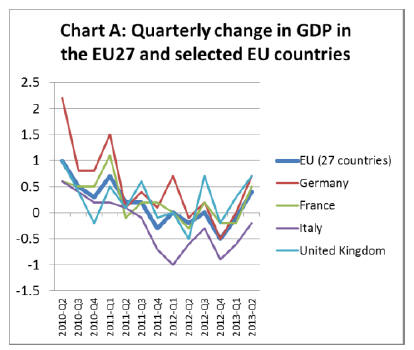
A rise in household spending underpinned the economic
momentum in many member states. There are also signs of
increased business optimism and higher manufacturing
output.
During the second quarter of 2013, there was robust GDP
growth in Germany (+0.7%), the UK (+0.7%) and France
(+0.5%). Although GDP continued to shrink in Italy (-
0.2%) and Spain (-0.1%), but the rate of decline was much
slower than during previous quarter.
The rise in GDP was mirrored in a significant
improvement in the Eurostat Economic Sentiment
Indicator between April and August 2013 (Chart B).
This indicator, which draws on a regular monthly survey
of perceptions and expectations in five sectors (industry,
services, retail trade, construction and consumers)
improved across a wide range of EU member states.
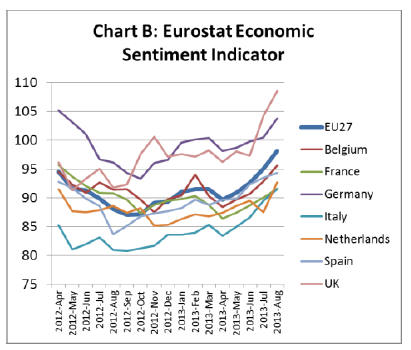
While economic conditions are improving, several factors
are likely to limit the pace of recovery. Particularly
notable amongst these are the high level of consumer and
government debt and the weakness of the labour market.
Europe's unemployment rate remains stubbornly high at
12.1%.
In some member states hardest-hit by Europe's debt crisis,
such as Greece and Spain, more than one in four people
don't have a job. Analysts say more dynamic growth will
be needed to spur investment and job creation there.
Still, even meagre growth in Europe provides a boon to the
global economy. The EU, which now totals 28 nations
following Croatia's accession in July, has a population of
some 500 million, and its annual gross domestic product
stands at around $17.3 trillion ¡ª both more than the U.S.,
which has a GDP of $16.6 trillion for 315 million people.
EU construction sector flat overall but positive signs in
UK and Germany
Short-term prospects for the European wood industry
continue to be dampened by the slow pace of recovery in
the construction sector. The Eurozone Construction
Confidence Index (Chart C) has remained flat at a low
level of around -30 since the beginning of 2013.
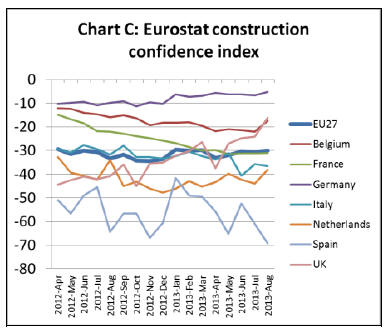
This means that construction companies across the EU
continue to have declining order books and low
employment expectations in the coming months. However,
construction confidence has remained comparatively high
in Germany and improved rapidly in the UK in recent
months.
The Eurostat Construction Production Index (Chart D),
which measures the seasonally adjusted production level,
increased slowly but consistently between March 2013 and
June 2013. This was due primarily to a strong rebound in
German construction in the summer months after a dip last
winter.
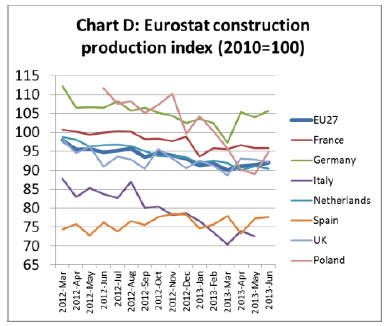
The Eurostat Building Permits Index (Chart E), which
provides a forward indicator of likely future construction
activity, suggests good prospects in Germany but flat or
declining prospects elsewhere in the EU. Building permits
are currently at around 85% of the 2010 level across the
EU as a whole.
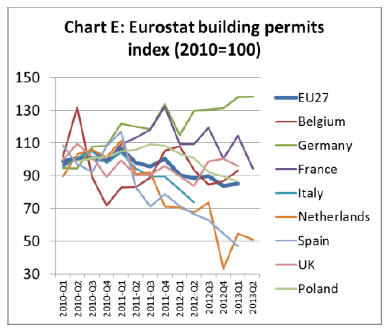
However permits issued in Germany this year are nearly
40% up on the level prevailing in 2010. In France and the
UK, building permits are at a similar level to 2010.
However permit levels have continued to fall sharply in a
few countries this year, notably Netherlands and Spain.
The Eurostat Index of Wood Joinery Production (which
covers all joinery products except flooring) indicates that
joinery activity across the EU in 2013 has remained flat at
around 85% of the level prevailing in 2010 (Chart F).
Joinery production in Germany has remained stable at
around the same level for the last 3 years. However
production declined sharply in Spain, France and Italy
between 2010 and 2012 before levelling out at a low level
this year.
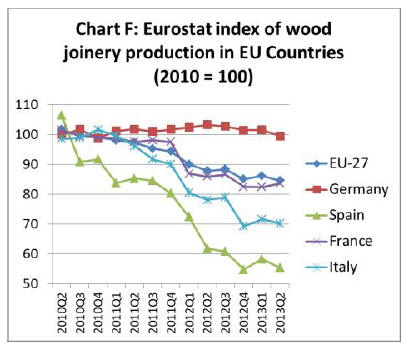
UK joinery manufacturers optimistic but sales volumes
are yet to rise
The latest British Woodworking Federation (BWF)
quarterly survey of joinery companies in the UK suggests
that the sector remains optimistic about an increase in
sales volumes for the remainder of 2013, despite slightly
disappointing results during the second quarter of the year.
On balance, respondents to the survey reported slightly
lower sales in the second quarter of 2013 compared to the
first quarter despite improving weather conditions. Order
books are also low with only 7% of companies reporting
orders for future work extending beyond 3 months.
Nevertheless, respondents were confident that sales
volumes would improve, with a balance of 19% predicting
an increase in the third quarter of 2013. A majority of
respondents said that they had been using less than 70% of
their production capacity for the past year. However, most
expected a significant increase in production in the second
half of 2013.
BWF conclude that ¨Danecdotal evidence and industry
predictions suggest that we could be looking at better
fortunes for joinery manufacturers in the third quarter, as
the housing recovery, a general uplift in construction work
and fair weather are all likely to boost activity.
But the second quarter results serve as a reminder that
growth for the joinery sector continues to be slow if at all,
and it shouldn¡®t be taken for granted in what remains an
exceptionally competitive marketplace.¡¬
New report indicates long term decline in European
construction
A newly released report suggests only poor prospects for
long-term growth of construction activity in Western
Europe. The ¨DGlobal Construction 2025¡¬ report by
research firms Global Construction Perspectives and
Oxford Economics predicts that the region¡®s construction
market will be 5% smaller in 2025 than in 2007.
This is due to a combination of declining real wages and
unemployment having a negative impact on house
building, as well as high levels of public debt meaning
there will be little funding available for infrastructure
investment.
The report forecasts that output growth will struggle to
reach 2% in any year between now and 2025.
However, the news is better for the UK. This is due to a
pressing need for new homes and renewed infrastructure
and also the apparent willingness of Chinese and Middle
Eastern sovereign wealth funds to invest in UK
infrastructure and real estate.
The report forecasts that UK construction output will grow
at 2.1% a year on average up to 2025. The report
concludes that by the end of the forecast period the size of
the UK market will rival that of Germany¡®s, with output of
$315bn and $342bn respectively.
There are also better prospects in Eastern Europe. The
population of Eastern Europe is expected to decline by
0.2% a year over the forecast period. However the report
says that strong economic growth should lead to increased
construction demand. It expects construction output in
Eastern Europe to grow on average by 4.6% a year over
the next 12 years, marginally higher than the global
average.
However, there are marked differences between Eastern
European countries. The best performers, Turkey and
Russia, are predicted to see average annual growth
exceeding 5%.
Russia is expected to move from being the ninth largest
construction market in the world in 2012 to the sixth by
2025. Growth in Turkey is forecast to be, if anything,
higher than in Russia, with rapid urbanisation and the need
to replace and upgrade the country¡®s housing stock driving
growth.
EU wood door consumption stable at a low level
Data newly released by Eurostat shows that production of
wooden doors across the EU in 2012 was valued at €6.04
billion, 2% less than the previous year. A 2.7% increase in
German production to €1.08 in 2012 was insufficient to
offset declining production elsewhere. Production value in
Spain fell 21% to €437 million in 2012, only a quarter of
the value of 2007 prior to the economic crises.
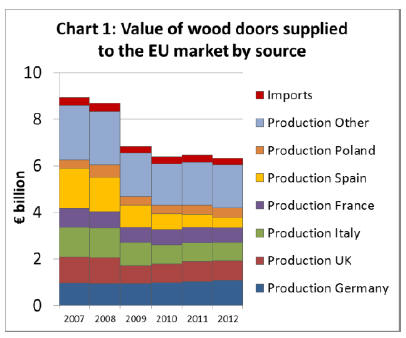
During 2012 there was also a 4.4% decrease in French
production to €640 million, and 1.4% decrease in Italian
production to €780 million. Production value in the UK
remained stable at €850 million in 2012.
In 2012, imports of wooden doors from outside the EU
were valued at €283 million, 2.3% less than the previous
year. Imports accounted for 4.5% of total supply of
wooden doors to the EU market in 2012, the same
proportion as the previous year.
Chart 2 shows recent quarterly trends in the value of EU
wooden door imports by supply country. While subject to
seasonal variation, import levels have been reasonably
consistent averaging around €70 million per quarter since
the start of 2011.
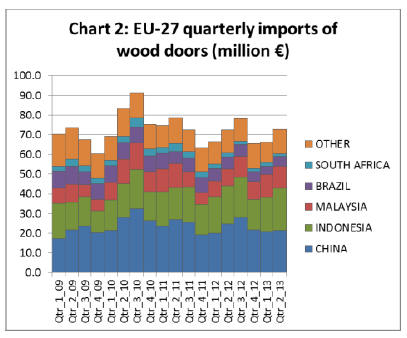
China is the largest single supplier accounting for 30% of
all import value during the first six months of 2013, down
from 32% during the same period of 2012.
The share of imports from Indonesia was 29% in the first
six months of 2013, up from 27% during the same period
last year. In 2013, imports from China have been destined
primarily for the UK (42%), Romania (18%) and France
(17%).
Wood window imports slide to negligible levels
According to Eurostat, production value of wood windows
in Europe was €6.76 billion in 2012, 1.6% less than the
previous year. Despite the economic downturn, Eurostat
report a 9% rise in Italian production of wood windows in
2012 to €1.65.
This rise offset falling production value in Germany (-
1.6% to €870 million), France (-2.0% to €630 million),
Denmark (-3.2% to €470 million), and the UK (-17% to
€380 million). Production value in Poland was €510
million , the same as the previous year.
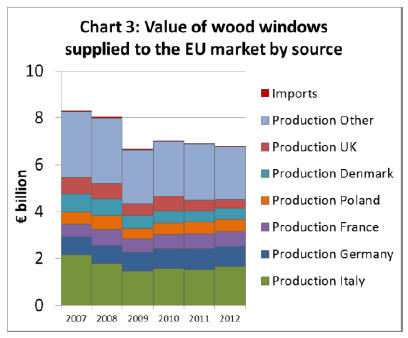
Domestic manufacturers are overwhelmingly dominant in
the European windows sector. Imports have not been
competitive in a market requiring regular supply of
consistent product at short notice to a highly fragmented
building sector in accordance with demanding national
quality and efficiency standards.
Imports of wood windows into the EU were valued at only
€31 million in 2012, 9% less than the previous year, and
only 0.5% of total supply. Norway is the largest non-EU
supplier of wood windows into the region, benefiting from
geographic proximity.
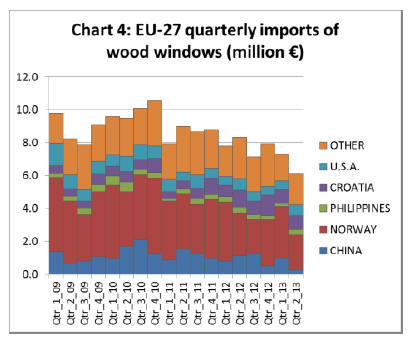
EU imports of wood windows from China have been
falling over the last 2 years and were valued at only €1.3
million in the first six months of 2013, down from €2
million in the same period of 2012. Wood window imports
from China are destined mainly for France, Belgium and
Poland.
Competition intensifies in the glulam sector
Data from the UNECE Timber Committee indicates that
European glulam consumption fell 2.6% to 2.83 million
m3 in 2012 (Chart 5). Germany and Austria have
traditionally been the largest markets for glulam, while
Italy and France showed rapid growth in consumption
prior to 2007.
Consumption of glulam in other European countries is still
low despite significant growth potential.
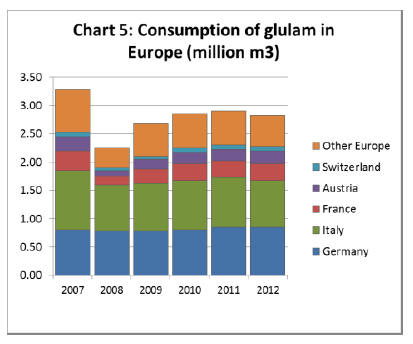
The downturn in EU consumption in 2012 was mainly due
to declining construction and other economic problems in
Italy. For 2012 Italy¡®s glulam consumption is estimated at
830,000 m3, down 5.7% compared to 2011.
Consumption in Austria increased 12% to 230,000 m3 in
2012, while consumption was stable in Germany (850,000
m3) and France (300,000 m3).
In 2012, 125,000 m3 of glulam was imported into the EU,
8% less than the previous year. In 2012 imports accounted
for 4.4% of total consumption, down from 4.7% in 2011.
Glulam imports have continued to decline this year. In the
first 6 months of 2013, imports were 57,300 m3, 15% less
than the same period in 2012.
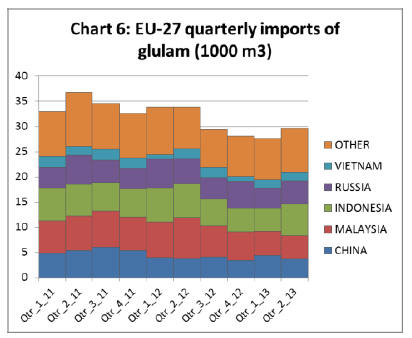
The leading external suppliers of glulam to the EU are
Malaysia, Indonesia and Russia, followed by China. In the
first 6 months of 2013 compared to the same period in
2012, EU imports declined from Malaysia (-38% to 9400
m3), Indonesia (-18% to 11000 m3) and Russia (-20% to
8600 m3). However imports from China increased by 3%
to 8000 m3, mainly due to rising sales in the UK.
The European glulam market is currently suffering from
saturation. Also, several other engineered wood products
are now competing with glulam in Europe, such as
laminated veneer lumber (LVL), which is gain importance
in northern Europe. Competition from LVL may intensify
this year as Pollmeier in Germany is expected to begin
production of LVL from beech, starting with 150,000 m3
of production capacity.
European glulam manufacturers have been increasing their
efforts to expand markets outside the EU, notably in Japan
and the Middle East. The main focus is on big projects and
eco-buildings, including government buildings, retail
developments and sports and recreation centres.
A big part of the market development strategy focuses on
European glulam producers¡® ability to provide a ¨Done-stop
shop¡¬ integrating design, manufacture, and installation.
Commenting on their Middle Eastern marketing operation
one large European manufacturer comments: ¨Dwe are
reducing out-sourcing and developing our own capacity to
manufacture steel connectors and undertake hybrid
buildings, combining wood with other materials, as well as
projects using solid timber frame and cross-laminated
timber.¡¬.
* The market information above has been generously provided by the
Chinese Forest Products Index Mechanism (FPI)
|